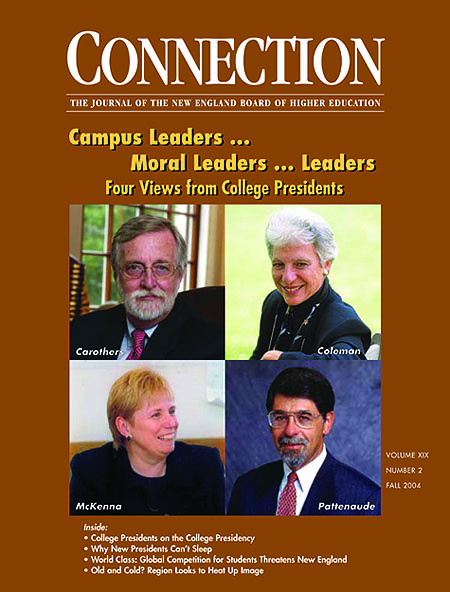
Click the cover image to view and download this issue in PDF format.
BOSTON—New England’s college presidents strike a delicate balance as they attempt to weigh in on major issues without alienating big financial donors or other campus constituencies, according to the Fall 2004 issue of Connection: The Journal of the New England Board of Higher Education.
The Fall issue of Connection features hard-hitting articles by New England college presidents and others about the college presidency with a particular focus on the college president as a public leader.
Authors include presidents Margaret McKenna of Lesley University, Richard Pattenaude of the University of Southern Maine, Robert Carothers of the University of Rhode Island, and Elizabeth Coleman of Bennington.
“One of the great unheralded advantages of New England’s concentration of colleges and universities is the potential public leadership of its 270 or so college presidents,” writes Connection Executive Editor John O. Harney. “The challenge they face is not that there are so many risks to speaking out, but rather, that there’s so much to speak out about.”
Connection is the journal of the nonprofit New England Board of Higher Education—and America’s only regional journal on higher education and the economy.
Among articles in the Fall 2004 Connection:
Balance Wheel • College presidents possess powerful bully pulpits—but how they use those perches trips alarm bells in and out of higher education. Stephen J. Nelson, a Brown University expert on the college presidency and author of the book, Leaders in the Crucible: The Moral Voice of College Presidents, urges presidents to use their moral authority to shield their campuses from becoming ideological battlegrounds.
Profiles in Caution • “It’s one thing to speak out on ‘safe’ topics like proposed changes to the federal Higher Education Act and the attendant dangers of government intrusions into the academic sphere,” observes Lesley University President Margaret A. McKenna. “But what voice should we give to the abridgement of individual civil liberties under the USA Patriot Act? What about gay marriage, abortion, Enron, tax policy and health reform?” McKenna answers with two compelling questions: “If college presidents don’t ask questions about war and civil liberties, who will?”
It’s Not About Me • University of Southern Maine President Richard Pattenaude argues that public university presidents owe it to their institutions not to let too much controversy sap energy, create resistance to change, or generate hostile opposition. “The presidency is not about me, my opinions and my view of the new world order,” he writes. “I consider it inappropriate to think I might somehow represent the political views of all the people who work and learn on our campus.”
Declaring Independence • University of Rhode Island President Robert L. Carothers offers a new model for public college and university presidents. Writes Carothers: “Today’s leaders in higher education will have to abandon, however grudgingly, the defense of financial entitlement and instead shift their focus on gaining the financial and management independence required to maintain the viability of their institutions.”
Connecting Thought and Action • Bennington College President Elizabeth Coleman describes a key challenge facing liberal arts colleges and their leaders: to accommodate a reciprocal relationship between thinking and doing. “Achieving a continuum between thought and action has never been easy—on the academic side is the fear of diluting intellectual rigor matched on the practical side by the fear of paralysis,” she writes. “If anything, the increasing specialization and narrowing of academic disciplines over the past decades has deepened the divide. … Academic rigor is increasingly reduced to technical competence, narrowness of focus and perpetuation of the status quo, while action is equated with mindless activity.”
Why New Presidents Can’t Sleep • The fierce pressures on new college presidents begin before the new leaders even arrive on campus. Massachusetts higher education consultants James E. Samels and James Martin explain why many new campus chiefs are leaving the job earlier than their predecessors.
World Class • The nearly 45,000 foreign students attending New England colleges and universities contribute $1.2 billion to the region’s economy each year in tuition payments, living expenses and discretionary spending. But New England’s historical leadership in attracting foreign talent faces serious new threats ranging from post-9/11 visa restrictions to stepped-up global competition for students. John F. Ebersole, associate provost and dean of extended education at Boston University, explains how New England could keep its edge.
Old and Cold? • That’s how outsiders view New England, according to the results of four national surveys conducted by the University of Connecticut’s Center for Survey Research and Analysis.Douglas G. Fisher , director of Economic & Business Development at Northeast Utilities, explains how a group of business leaders are using the findings to heat up the region’s image.
Advice for Regionalists • Charles H.W. Foster shares more than 50 years of regional experience with a primer on making regional institutions work.
Excerpts • Boston College higher education scholar Philip G. Altbach warns in the quarterly International Higher Education that universities can no longer attract the “best and the brightest” due to deteriorating working conditions in academia. The National Retail Federation publicizes the back-to-school buying habits of U.S. college students and their parents.
Books • Tufts University Admissions Director Lee Coffin reviews Leveling the Playing Field: Justice, Politics and College Admissions. Freelance writer Alan R. Earls reviews A Century of Honesty, Energy, Economy, System: Wentworth Institute of Technology, 1904-2004.
[ssba]
